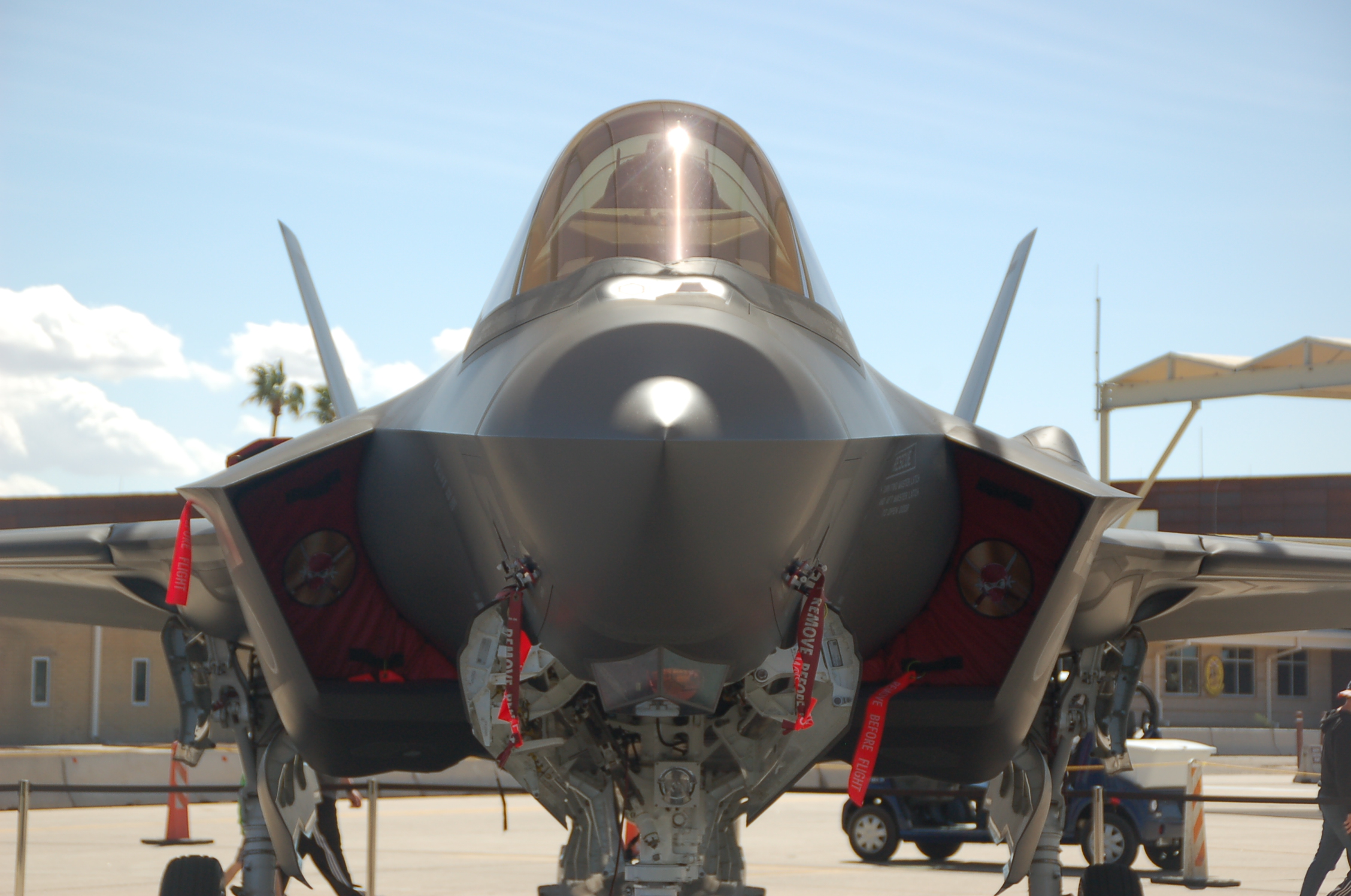.“This post contains affiliate links. If you shop using these links I make a small commission, but you are never charged any extra! And as always, my opinions are completely my own.”
This week was the Thunder and Lightning over Arizona Airshow. From fast, precision military demonstrations to gravity-defying aerobatic acts, airshows offer something for every nerd. We wait all year for our local airshow. Most airshows also feature jet-propelled cars or trucks, parachutists, and a huge selection of on-the-ground displays and activities. A day at the air show is a fantastic and memorable experience for the whole family.
If you have never been to an airshow it might seem a little overwhelming. Here are a few tips for attending your first airshow.
What to Bring:

- Ear protection, especially important for kids! The Snug Kids Earmuffs
is a great option.
- Sunblock
- Portable chairs – most bases will also allow you to rent folding chairs. A Camping Chair is portable and light.
- Strollers
- Cameras
- Blankets
Be sure the check the website to see what you are allowed to bring in. Most Air Force bases will not allow large bags or coolers. Diaper bags are normally allowed but will be searched at the gate.
Arrive Early
Parking can get crowded and finding a good spot on the flight line will give you the best view. There are usually a limited number of bleacher seats available. You can sometimes find shad under open hangers. You will want to be able to see the flight line so you will have a good view of low flybys and the jet car.
What to See
There is a lot to take in at an airshow. There will normally be multiple food vendors and a beer garden for the adults. You will have ground displays to see and walk through, a kids zone, and the performers.
Ground Displays
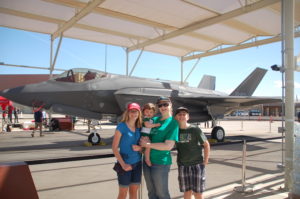
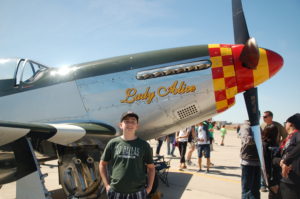
This is where the planes are parked and several of them are open for you to be able to walk through. Normally, the website will provide information as to what static displays will be available. My favorites are the F-14 and the SR71 Blackbird. I am lucky that we have both at the local Air Museum so I get to visit as often as I like. My son loves the older planes and is looking forward to seeing the P51 Mustang and the B-52 Stratofortress. Often you can sit is a fighter jet and get a picture taken.
Kid Zone
Normally there is an area for the kids to take a break from the action. At most airshows I have attended there are rock walls, bounce houses, and obstacle courses. At a few airshows, I have seen virtual reality flight simulators. This is a great way to have the little nerds burn off some energy between performances.
Performers
There are normally many performers at an airshow. These can include precision flying squads, heritage performers, combat search and rescue demonstration, stunt performers, jet cars, and parachute teams.
US Air Force Thunderbirds
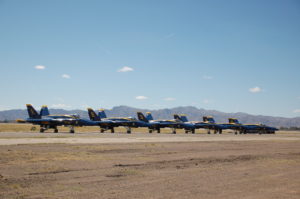
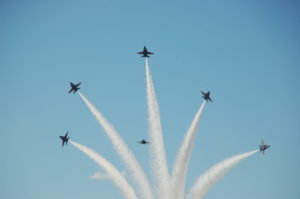

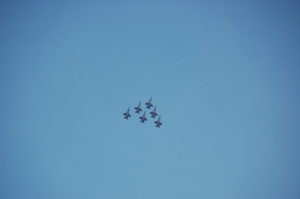
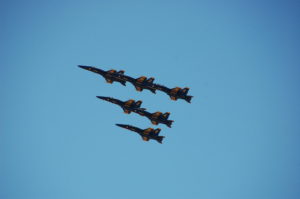
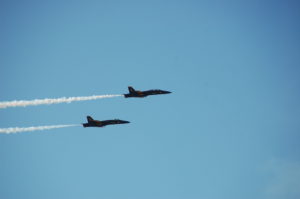
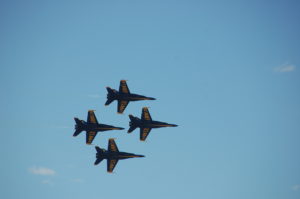
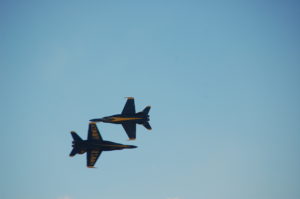
We get to see the US Air Force Thunderbirds. This precision squad flies in the F-16 Fighting Falcon – the Air Force’s premier multi-role fighter jet. You can find the Thunderbirds Schedule of Events on their website. If you are attending an airshow on a Navy or Marine Base, you will most likely see the Navy’s Blue Angels. The Blue Angels fly the F/A-18 Hornet and you can find their Schedule of Events listed on their website.
Heritage Performers
Heritage Flights present the evolution of air power by flying today’s state-of-the-art fighter aircraft in close formation with vintage fighter aircraft. This is always an amazing display and gives you a chance to see how far technology has come in flight.
The Thunder & Lightning Over Arizona Air Show’s Heritage Flight featured a 4-ship formation featuring the U.S. Air Force A-10 Thunderbolt, the F-22 Raptor, and the F-35 Lightning II escorting the Korean War-era F-86 Sabre.
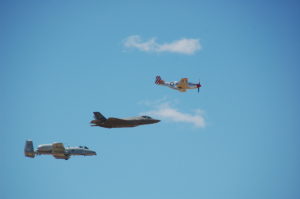
A-10 Thunderbolt
The A-10 Thunderbolt is a workhorse for the Air Force. This aircraft provides close air and quick-action support for troops against helicopters, vehicles, and ground troops. The A-10 entered service in 1976 and is the only production-built aircraft that has served in the USAF that was designed solely for close air support(CAS). Its secondary purpose is to provide forward air controller – airborne (FAC-A) support, by directing other aircraft in attacks on ground targets.
F-22 Raptor
The F-22 Raptor is the most advanced fighter aircraft flying in the world today. The Raptor’s combination of stealth, maneuverability, supercruise ability, and integrated avionics, represents an exponential leap in warfighting capabilities. The Raptor performs both air-to-ground and air-to-air missions allowing full realization of operational capabilities.
F-35 Lightning II
The F-35 Lightning II is the is a fifth-generation fighter. It is the newest fighter aircraft in the fleet. The F-35 combines advanced stealth, integrated avionics, sensor fusion, and superior logistics support with the most comprehensive integrated sensor package of any fighter aircraft in history. The F-35’s advanced stealth allows pilots to penetrate areas without being detected by radars that other fighters cannot.
F-86 Sabre
The three modern jets will be flying with the F-86 Sabre, also called the Sabrejet. The Sabre is best known as the United States’ first swept wing fighter that would counter the swept-wing Soviet MiG-15 in high-speed dogfights. The F-86 fought in some of the earliest jet-to-jet battles in history. Even though it was developed in the late 1940s and was outdated by the end of the 1950s, the Sabre proved versatile and adaptable and continued as a front-line fighter in numerous air forces around the world. The last active operational F-86 were retired in 1994 by the Bolivian Air Force.
Combat Search and Rescue Demo
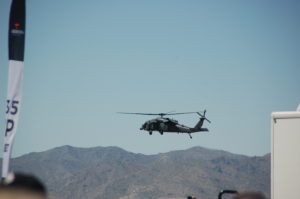
This is always exciting. The combat search and rescue demo is a realistic demonstration of the aircraft and techniques used in real missions. It is always loud and explosive.
Parachute Team
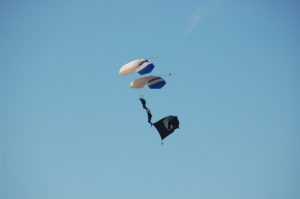
This year we will be lucky enough to see the Wings of Blue Demonstration Team. The Wings of Blue demonstrated their intricate aerial skills and include representatives from both the United States Air Force and the Air Force Academy. One amazing thing about this team is that they take the time to impact each community they visit throughout the show season, not only at the demonstration site but also through hospital and school visits.
The number of jumpers in the demo can vary from 4-14 and they will jump from altitudes varying from 2500’ to 15000’ above the ground. Demonstration jumpers normally wear smoke grenades to add to their visibility. Jumpers also can carry any type of flag, multiple flags, streamers, and also fly a massive 800 square foot American Flag. One of their most popular maneuvers is the Wings of Blue bomb-burst, in which jumpers utilize their flying skills to join up in formation in the sky. Upon a command from the lead jumper, each skydiver performs a 180-degree turn and travels in separate directions of the flight line, creating an incredible burst effect. They are incredible and we look forward to seeing them at airshows.
WWII Plane Demonstration
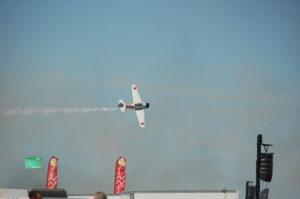
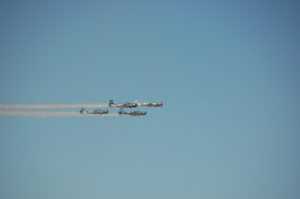
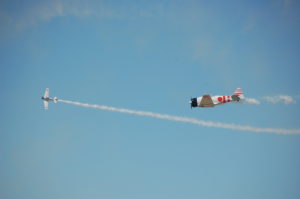
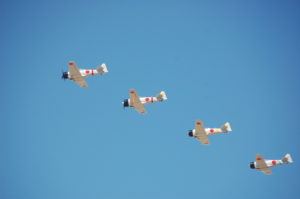
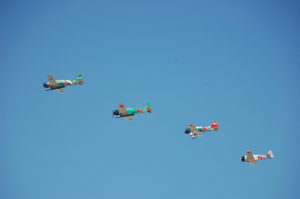
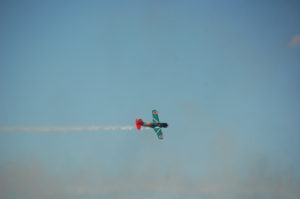
This is my son’s favorite part of the airshow. For those who love history, this demonstration is sure to be a thrill. This is a heart-pounding reenactment of a lone B-25 making its way back to base somewhere over the Pacific. Out of the sun comes a Japanese Zero intent on taking down the lone plane. But little does the Zero know that a U.S. Navy F-6 Hellcat is in the area. The F-6 comes to the defense of the lone bomber and will face off against the Zero.
Jet Car/Truck
Jet cars and trucks are showstoppers and when the engines fire up, everyone knows it. There is usually a mass spectator migration to the flight line to see what their ears have already told them is going to be fantastic.
You will be amazed to see the licks of flame, both horizontal and vertical, followed by clouds of smoke that comes just before a blast down the runway. It is an incredible site and one that the little nerds will not forget.
Stunt Planes
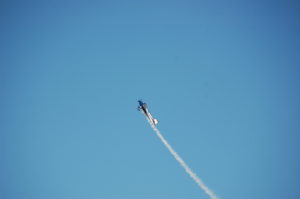
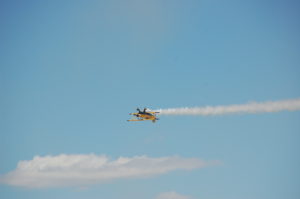
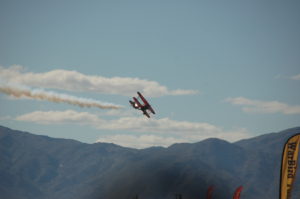
Stunt planes are a staple of airshows. This year we are lucky enough to have three of the best stunt performers on the industry: Vicky Benzing, Kent Pietsch, and Kirby Chambliss.
Vicky Benzing
Vicky Benzing flys a beautiful Stearman. It was manufactured in 1940 by Boeing as a military trainer in WWII.
In 1990, the plane was restored and converted back to a standard acrobatic category aircraft. Vicky purchased the airplane in 1998 and loves to fly the airplane at air shows, demonstrating the grace and beauty of flight in this early trainer.
Vicky’s Stearman remains as originally built 75 years ago, except for the engine and a smoke system. Because the trailing edge of the airplane wing now has 2 ailerons instead of 4, it takes 2 hands on the stick and a lot of muscle to roll it. Ailerons are used to control lateral balance. Vicky has learned to keep positive G’s on her Stearman at all times, just as the WWII pilots would have done. She is amazing to watch and a true steward of this timeless masterpiece.
Kent Pietsch
If you are lucky, you get to see Kent Pietsch, who is sponsored by Jelly Belly. Kent brings his aerobatic comedy act to the skies in his bright yellow, jelly bean-decorated, 1942 Interstate Cadet aircraft. During his performance, Pietsch performs extreme maneuvers such as a dead stick, or a total power off, routine from an altitude of 6,000 feet. Pietsch will also land the aircraft on top of his RV.
Pietsch began his flying career at a young age and took his first solo flight at 16 years old. In 1974, he restored his Interstate Cadet and began flying air shows with his father and brother, Gary.
Kirby Chambliss
Kirby Chambliss is a stunt staple and one of the most outstanding pilots ever to fly air show. He also flies in the Red Bull Air Races. He holds two World Titles and 10 race victories, which puts him third on the all-time wins list.
Chambliss grew up racing motocross but always knew he wanted to become a pilot. He began flying at the age of 13 and by 24 he was the youngest commercial pilot at Southwest Airlines.
His aerobatics career began in 1985 and he won five US National Championships. He was the 2000 Freestyle World Champion and has won 13 World Championship medals. Chambliss has been flying the Zivko Edge 540 and jokes that he has flown the plane so much that the controls and wings are mere extensions of his own arms.
Hopefully, this will spark a love of aviation in your nerd. A day at the air show is a fantastic and memorable experience for the whole family. Have a great time.
Enjoying MommyNerdist? Sign up for our free newsletter today!

